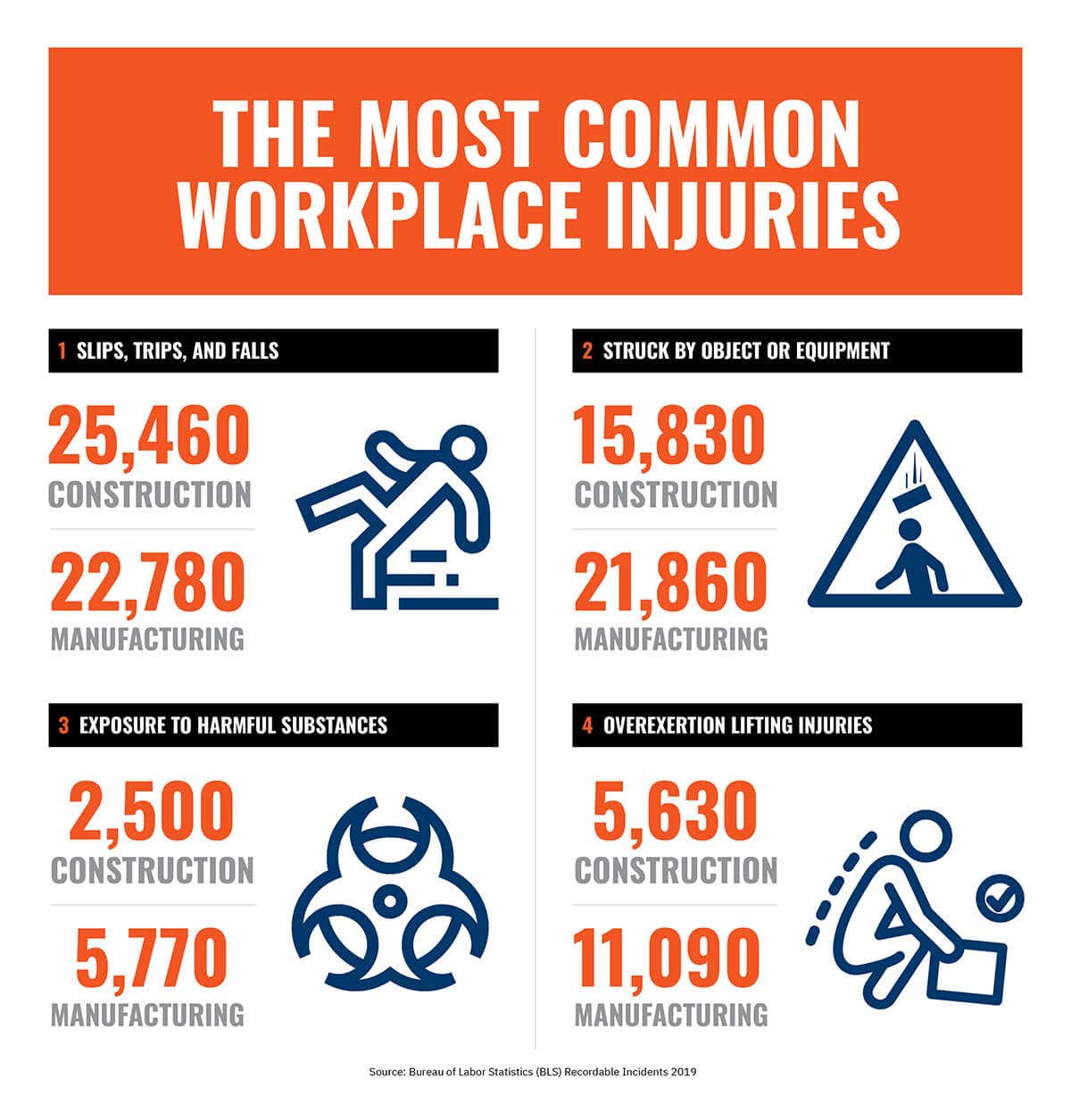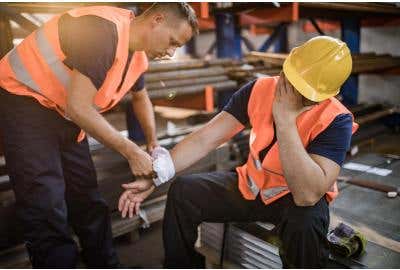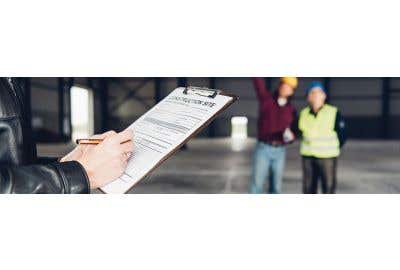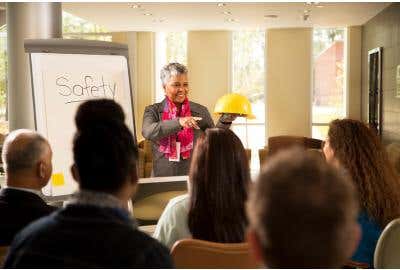How To Avoid the Most Common Workplace Injuries

A deep dive into the four common non-fatal injury types across manufacturing and construction, with suggested best practices for mitigating risk amongst your workforces.

Slips, Trips, and Falls Bureau of Labor Statistics (BLS) Recordable Incidents 2019
- Construction: 25,460
- Manufacturing: 22,780
Regarding slip, trip and fall injuries, there are two major areas of occupational safety emphasis across each industry: (1) proper use of equipment for working at heights, and, (2) ‘housekeeping’.
Work at heights commonly involves deployment of scaffolding, scissor lifts, personal fall arrest systems, or ladders, and often in combination. Each of these implements carry unique safety considerations.
As personal fall arrest systems continue to grow in usage, these devices require more attention from environmental health and safety (EHS) teams. Remember the following points of emphasis when addressing personal fall arrest:
- Train all participating workers on proper use for each type of fall arrest system.
- Inspect each personal fall arrest system device before use.
- Inspect harness for tight fit. Loose-fitting harnesses and failure to secure rigging are contributing factors in many injury cases.
- Only use shock absorbing harnesses in areas with adequate fall clearance.
To prevent fall injuries when working at heights, ClickSafety recommends the following online training:
Fall Protection For Construction (Introduction) Safety Pack
Fall Protection For Construction (Intermediate) Safety Pack
Fall Prevention & Protection For General Industry
“Housekeeping” is a common term for workspace cleanliness. Disorderly working environments pose hazards beyond slips, trips, and falls, and are frequently responsible for these injury types. This is an area of safety that requires constant vigilance for EHS teams. Clean working environments make it easier to spot other safety hazards and support operational efficiency by allowing workers to focus on their work.
Here are a few considerations and best practices:
- Build time into the workday for workstation clean-up.
- Set workspace hygiene expectations during orientation for new hires.
- Conduct worker performance evaluations including workspace hygiene.
- Clean working environments to make it easier to spot other safety hazards.
- Keep workers focused on their work by maintaining clean work environments. Clean workplaces support operational efficiency and removes distractions.
With 20 years of safety training expertise, ClickSafety recommends the following online courses to help prevent recordable Slip, Trip, or Fall injuries:
Slips, Trip And Falls For Construction
Slips, Trips And Fall For General Industry
Struck By Object or Equipment
Bureau of Labor Statistics (BLS) Recordable Incidents 2019
- Construction: 15,830
- Manufacturing: 21,860
Struck-by injuries occur with high frequency in the construction and manufacturing sectors. Accidents involving forklifts (or “powered industrial trucks” – OSHA), skid steer loaders, boom trucks, etc., account for a significant amount of recordable injuries in this category. Such accidents typically result from failure to follow established safety protocol – moving too fast, operating while distracted, and moving through working environments restricted to pedestrian traffic.
In many cases, lack of operator awareness is the fundamental contributing factor. However, communication breakdown between pedestrian workers and heavy equipment operators is an often overlooked, underlying factor. Remember these points of emphasis:
- Establish visual and/or verbal contact with operators at all times.
- Maintain awareness in loud environments and when wearing hearing protection.
- Rigorously test heavy equipment operators to demonstrate proficiency.
- Hire operators for experience and safety record.
With 8 million courses delivered worldwide, ClickSafety recommends the following online training to prevent Struck-By injuries:
Focus Four Struck-By Fatality Prevention For Construction
Industrial Facility Safety Awareness For Manufacturing
Safe materials handling and personal protective equipment (PPE) are connected in the struck-by injury category, through incidents involving fallen objects. Failure to safely stack and secure materials, along with exceeding load bearing capacity, are frequent factors in industrial struck-by accidents. In construction, struck-by accidents are closely associated with objects falling off of scaffolding.
In manufacturing, struck-by accidents are common to warehousing operations, where storage zone space is maximized through verticality. Here are some tips for improving safety in this area:
- Store irregular pallet loads at ground level.
- Perform walk-through safety audits with groups of employees.
- Train employees to spot – and abate – loads that appear unsafe.
- Institute a mandatory hard hat program involving signage, training, and designated ‘hard hat required’ spaces.
A leader in online safety training since 1999, ClickSafety recommends the following online training for Struck-By injury prevention in manufacturing settings:
Forklift Hazards for Construction
Safe Forklift Operation Awareness For Manufacturing
Powered Industrial Truck Safety Awareness For Manufacturing
Exposure to Harmful Substances
Bureau of Labor Statistics (BLS) Recordable Incidents 2019
- Construction: 2,500
- Manufacturing: 5,770
Due to the nature of work in each industry sector, some handling of either flammable material, noxious fume emitting chemicals, or toxic substances, is inevitable for much of the workforce. These substances range from the relatively common, like fuels, paints, solvents, and chemical bonding agents, to those with select applications, such as industrial cleaning agents involving chlorine. Many of the substances present a dual threat to worker health: direct contact to the body and as a breathable hazard.
In construction, hydrogen sulfide, a naturally occurring, heavy environmental gas, is a frequently encountered hazardous substance that is responsible for numerous, harmful work exposures annually.
Most commonly present when working below ground in confined-space areas like wells, tunnels, sewage and drainage systems, this extremely flammable gas may also prove fatal when inhaled. Remember these protocols for construction teams working below ground in environments where hydrogen sulfide may be present:
- Deploy portable air quality sampling devices and/or gas detection systems, to first determine the risk of exposure.
- Use adequate ventilation systems to mitigate the hydrogen sulfide hazard.
- Use respirators rated for exposure (personal protective equipment).
To help prevent injuries related to hydrogen sulfide exposure, along with other Hazardous Substances, ClickSafety offers these online course:
Subpart Z: Toxic And Hazardous Substances For General Industry
HAZWOPER 16-Hour For All Industries
Solvent Safety Awareness For Manufacturing
Hexavalent chromium is a known carcinogen and welding byproduct gas associated with stainless steel work, and common to construction and manufacturing settings. Federal OSHA, along with many state-run occupational safety programs, have developed special emphasis programs to raise hazard recognition amongst the workforce on the danger of ‘hex chrome’. Best practices for avoiding exposure to hexavalent chromium involve:
- Avoid stainless steel hot work in confined spaces.
- Ensure proper ventilation in all environments.
- Always use proper respiratory protection.
The following online workforce training raises awareness of the dangers of hexavalent chromium and other Hazardous Substances common to manufacturing settings:
HAZWOPER 16-Hour For All Industries
Hazardous Material Awareness For Manufacturing
Overexertion Lifting Injuries
Bureau of Labor Statistics (BLS) Recordable Incidents 2019
- Construction: 5,630
- Manufacturing: 11,090
In both construction and manufacturing, exertion injuries sideline a considerable amount of workers. Ability to lift and carry objects up to certain weight thresholds is a common job requirement for many roles in each industry. Typically associated with lifting heavy objects, lifting objects improperly, and repetitive motions, resulting back strain injuries are a focal point for many safety teams.
Best practices for reducing or eliminating back injuries involve restrictions on how much weight any individual can attempt to carry at work, engineering controls to eliminate the necessity to lift any heavy object, and training on proper lifting techniques. Here are a few special safety considerations related to back safety:
- Response to lifting strain must be included in proper lifting technique training.
- Instruct workers on how to perform strenuous tasks safely.
- Train to determine which lifting activities to avoid.
- Train all construction and manufacturing employees on general overexertion lifting awareness-level.
Occupational training for back safety is, for much of the workforce, the only formal education that individuals receive on the topic; is an effective way to reduce the number of injuries while promoting healthy behaviors for workers on and off the job.
With over 300 occupational safety courses, ClickSafety recommends the following online training:
Lifting And Back Injury Prevention For General Industry
Safety For Lifting Devices Awareness For Manufacturing




